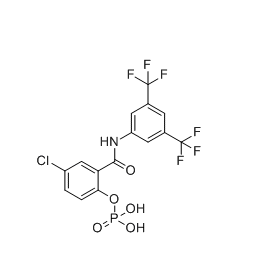| Cas No.: | 634913-39-6 |
| Chemical Name: | 2-{[3,5-Bis(trifluoromethyl) phenyl]carbamoyl}-4-chlorophenyl dihydrogen phosphate |
| Synonyms: | AER-271|AER271 |
| SMILES: | C1=CC(=C(C=C1Cl)C(=O)NC2=CC(=CC(=C2)C(F)(F)F)C(F)(F)F)OP(=O)(O)O |
| Formula: | C15H9ClF6NO5P |
| M.Wt: | 463.653 |
| Purity: | >98% |
| Sotrage: | 2 years -20°C Powder, 2 weeks 4°C in DMSO, 6 months -80°C in DMSO |
| Description: | AER-271, a phosphonate prodrug derivative of AER-270, is an aquaporin-4 (AQP4) inhibitor for the research of acute ischemic stroke[1]. |
| Target: | Aquaporin-4 (AQP4)[1] |
| In Vitro: | AER-271 is converted in vivo to AER-270 by endogenous phosphatases. AER-271 blocks acute cerebral edema and improves early outcome in a pediatric model of asphyxial cardiac arrest[1]. AER-271 reduces cerebral edema and improves neurological outcomes in rodent ischemic stroke models. Mice treated with AER-271 (5 mg/kg; i.p. injection) show improved outcomes and reduced cerebral edema in a model of ischemic stroke[2]. Animal Model: Male mice (C57BL/6J, 8-12 week-old, 25-30 g)[2] Dosage: 5 mg/kg Administration: Treated by i.p. injection Result: Had better outcomes with an average neurological score of 0.89±0.31 compared with control mice receiving vehicle had an average neurological score of 2.50±0.62. |
| References: | [1]. Wallisch JS, et al. The aquaporin-4 inhibitor AER-271 blocks acute cerebral edema and improves early outcome in a pediatric model of asphyxial cardiac arrest. Pediatr Res. 2019 Mar;85(4):511-517. [2]. Farr GW, et al. Functionalized Phenylbenzamides Inhibit Aquaporin-4 Reducing Cerebral Edema and Improving Outcome in Two Models of CNS Injury. Neuroscience. 2019 Apr 15;404:484-498. |

 To enhance service speed and avoid tariff delays, we've opened a US warehouse. All US orders ship directly from our US facility.
To enhance service speed and avoid tariff delays, we've opened a US warehouse. All US orders ship directly from our US facility.




















